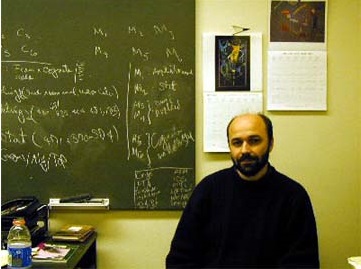
Rumen Dimitrov, Professor
Specializing in Logic
Education
Ph. D., George Washington University (Mathematics, Valentina Harizanov)
M. S., University of Sofia, Bulgaria (Mathematical Logic and its Applications, Dimiter Skordev)
Contact Information
Office: Morgan Hall 437
Phone:
(309) 298-1485
Email:
RD-Dimitrov@wiu.edu
Website
Courses
Math 101: Conceptions of Mathematics
Math 255: Discrete Mathematical Structures for Computer Science
Research Interests
Research: My research is in Computability and Computable Model Theory. I am studying the structure of the lattice of computably enumerable vector spaces L(V∞) and its factor lattice L*(V∞).
I am mostly interested in the open problems listed in The Handbook of Recursive Mathematics (Computable Algebras and Closure Systems: Coding Properties, by Downey and Remmel). V. Harizanov and I recently [in a paper 2015, 2016 published in Algebra and Logic] provided an answer to Question 5.8 (p.1031). Earlier, in a paper published in 2004, I provided a solution to Question 5.4 (p.1031) from The Handbook.
Research with undergraduate students: I would like to encourage interested students to explore different aspects of recursion theory and its application in vector spaces. Mathematical studies sets in general, while recursion theory studies their information content. The Turing degrees of the sets are measures of their information content. The most "orderly" sets are called recursive and have Turing degree 0. I would like to propose the following topics:
A. Recursion Theory:
- Post Program: Explore the simple, hypersimple, and hyperhypersimple sets.
- Oracle construction of non-R.E. degrees and the forcing method in recursion theory.
- The Finite Injury priority method. Present the original Friedberg-Muchnik Theorem.
- Major sets.
B. Recursively Enumerable Vector Spaces:
- Present the Fundamental Theorem of Projective Geometry.
- Prove the Existence of Maximal Computably Enumerable Vector Spaces.
- Present the Existence of R.E. spaces with no extendable basis.
Some Research Projects I Supervised:
Lattice Theory (Birkhoff's representation theorem); Automorphisms of a Vector Space; Satisfiability of Horn Sentences; Using Principal Component Analysis to Extract Meaning from Text; Rainbow Mathematics; Matrix Operatons and Applications.
Publications
Most Recent Publications in Computable Model Theory:
- Dimitrov, R., Harizanov, V., Morozov A., Shafer P., Soskova A., & Vatev S. (2019). Cohesive Powers of Linear Orders. Computing with Foresight and Industry. CiE 2019. Lecture Notes in Computer Science, 11558, Manea F., Martin B., Paulusma D., Primiero G., eds., Springer, pp. 168-180.
- Dimitrov, R., & Harizanov, V. (2017). The lattice of computably enumerable vector spaces. Computability and Complexity, A. Day, M. Fellows, N. Greenberg, B. Khoussainov, A. Melnikov, and F. Rosamond, eds., Springer, pp. 366-393.
- Dimitrov, R., Harizanov, V., & Morozov A. (2016). Automorphism groups of substructure lattices of vector spaces in computable algebra. 12th Conference on Computability in Europe, CiE 2016, A. Beckmann, L. Bienvenu, and N. Jonoska, Lecture Notes in Computer Science 9709, Springer, Heidelberg, pp. 251-260.
- Dimitrov R.D., & Harizanov, V. (2016). Orbits of maximal vector spaces. Algebra and Logic, 54:6, 440-477. (This is the English translation, published in Algebra and Logic by Springer in 2016, the paper appeared first in Russian, see below.)
- P. Д. Димитров, & В. Харизанова (2015). Орбиты максимальных векторных пространств, Алгебра и логика, 54:6, 680–732.
- Dimitrov, R., Harizanov, V., Miller, R., & Mourad, K.J. (2014). Isomorphisms of non-standard fields and Ash's Conjecture. Language, Life, Limits: 10th Conference on Computability in Europe, CiE 2014, eds. A. Beckmann, E. Csuhaj-Varju, and K. Meer, Lecture Notes in Computer Science 8493 (Berlin: Springer-Verlag), 143-152.
Earth and Space Sciences:
- Reuter, D., et al. (2001). The LEISA/Atmospheric Corrector (LAC) on EO-1,” Geoscience and Remote Sensing Symposium IGARSS '01, IEEE 2001 International, vol.1, pp. 46-48.
- Dimitrov, R. (2000). Co-registration algorithms for the next-generation earth-observing imagers.The Goddard Earth Sciences and Technology Center Annual Report, pp. 117-118.
- McCabe, G., et al. (1999). Observations using the airborne linear etalon imaging spectral array: 1 to 2.5 micron hyperspectral imager for remote sensing applications. Proceedings SPIE Vol. 3870, pp. 140-149.

Connect with WIU: